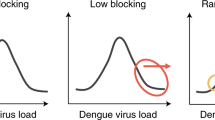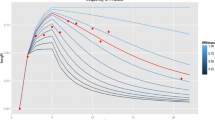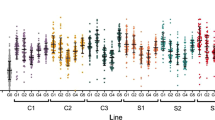Abstract
Genetic manipulations of insect populations for pest control have been advocated for some time, but there are few cases where manipulated individuals have been released in the field and no cases where they have successfully invaded target populations1. Population transformation using the intracellular bacterium Wolbachia is particularly attractive because this maternally-inherited agent provides a powerful mechanism to invade natural populations through cytoplasmic incompatibility2. When Wolbachia are introduced into mosquitoes, they interfere with pathogen transmission and influence key life history traits such as lifespan3,4,5,6. Here we describe how the wMel Wolbachia infection, introduced into the dengue vector Aedes aegypti from Drosophila melanogaster7, successfully invaded two natural A. aegypti populations in Australia, reaching near-fixation in a few months following releases of wMel-infected A. aegypti adults. Models with plausible parameter values indicate that Wolbachia-infected mosquitoes suffered relatively small fitness costs, leading to an unstable equilibrium frequency <30% that must be exceeded for invasion. These findings demonstrate that Wolbachia-based strategies can be deployed as a practical approach to dengue suppression with potential for area-wide implementation.
This is a preview of subscription content, access via your institution
Access options
Subscribe to this journal
Receive 51 print issues and online access
$199.00 per year
only $3.90 per issue
Buy this article
- Purchase on Springer Link
- Instant access to full article PDF
Prices may be subject to local taxes which are calculated during checkout



Similar content being viewed by others
References
Gould, F. & Schliekelman, P. Population genetics of autocidal control and strain replacement. Annu. Rev. Entomol. 49, 193–217 (2004)
Turelli, M. & Hoffmann, A. A. Cytoplasmic incompatibility in Drosophila simulans: dynamics and parameter estimates from natural populations. Genetics 140, 1319–1338 (1995)
Moreira, L. A. et al. A Wolbachia symbiont in Aedes aegypti limits infection with dengue, chikungunya, and Plasmodium . Cell 139, 1268–1278 (2009)
McMeniman, C. J. et al. Stable introduction of a life-shortening Wolbachia infection into the mosquito Aedes aegypti . Science 323, 141–144 (2009)
Kambris, Z., Cook, P. E., Phuc, H. K. & Sinkins, S. P. Immune activation by life-shortening Wolbachia and reduced filarial competence in mosquitoes. Science 326, 134–136 (2009)
Bian, G. W., Xu, Y., Lu, P., Xie, Y. & Xi, Z. Y. The endosymbiotic bacterium Wolbachia induces resistance to dengue virus in Aedes aegypti . PLoS Pathog. 6, e1000833 (2010)
Walker, T. et al. A non-virulent Wolbachia infection blocks dengue transmission and rapidly invades Aedes aegypti populations. Nature 10.1038/nature10355 (this issue).
Kyle, J. L. & Harris, E. Global spread and persistence of dengue. Annu. Rev. Microbiol. 62, 71–92 (2008)
Guzman, M. G. et al. Dengue: a continuing global threat. Nature Rev. Microbiol. 8. S7–S16 (2010)
Turelli, M. & Hoffmann, A. A. Rapid spread of an inherited incompatibility factor in California Drosophila . Nature 353, 440–442 (1991)
Riegler, M., Sidhu, M., Miller, W. J. & O’Neill, S. L. Evidence for a global Wolbachia replacement in Drosophila melanogaster . Curr. Biol. 15, 1428–1433 (2005)
Turelli, M. Cytoplasmic incompatibility in population with overlapping generations. Evolution 64, 232–241 (2010)
Yeap, H. L. et al. Dynamics of the ‘popcorn’ Wolbachia infection in Aedes aegypti in an outbred background. Genetics 187, 583–595 (2011)
Caspari, E. & Watson, G. S. On the evolutionary importance of cytoplasmic sterility in mosquitos. Evolution 13, 568–570 (1959)
McMeniman, C. J. & O’Neill, S. L. A virulent Wolbachia infection decreases the viability of the dengue vector Aedes aegypti during periods of embryonic quiescence. PloS Neglect. Trop. Dis. 4, e748 (2010)
Osborne, S. E., Leong, Y. S., O’Neill, S. L. & Johnson, K. N. Variation in antiviral protection mediated by different Wolbachia strains in Drosophila simulans . PLoS Pathog. 5, e1000656 (2009)
Endersby, N. M. et al. Changes in the genetic structure of Aedes aegypti (Diptera: Culicidae) populations in Queensland, Australia, across two seasons: implications for potential mosquito releases. J. Med. Entomol. (in the press)
Barton, N. H. & Turelli, M. Spatial waves of advance with bistable dynamics: cytoplasmic and genetic analogs of Allee effects. Am. Nat. 10.1086/661246 (2011)
Hemme, R., Thomas, C., Chadee, D. & Severson, D. Influence of urban landscapes on population dynamics in a short-distance migrant mosquito: evidence for the dengue vector Aedes aegypti . PLoS Negl. Trop. Dis. 4, e634 (2010)
Reiter, P., Amador, M. A., Anderson, R. A. & Clark, G. G. Dispersal of Aedes aegypti in an urban area after blood feeding as desmonstrated by rubidium-marked eggs. Am. J. Trop. Med. Hyg. 52, 177–179 (1995)
Harrington, L. C. et al. Dispersal of the dengue vector Aedes aegypti within and between rural communities. Am. J. Trop. Med. Hyg. 72, 209–220 (2005)
David, M. R., Lourenco-de-Oliveira, R. & de Freitas, R. M. Container productivity, daily survival rates and dispersal of Aedes aegypti mosquitoes in a high income dengue epidemic neighbourhood of Rio de Janeiro: presumed influence of differential urban structure on mosquito biology. Mem. Inst. Oswaldo Cruz 104, 927–932 (2009)
Laven, H. Eradication of Culex pipiens fatigans through cytoplasmic incompatibility. Nature 216, 383–384 (1967)
Curtis, C. F. Genetic control of insect pests: growth industry or lead balloon? Biol. J. Linn. Soc. 26, 359–374 (1985)
Foster, G. G. Genetic control of sheep blowfly (Lucilia cuprina) and the logistics of the CSIRO control program. Wool Technol. Sheep Breed. 28, 5–10 (1980)
De Barro, P., Murphy, B., Jansen, C. & Murray, J. The proposed release of the yellow fever mosquito, Aedes aegypti containing a naturally occurring strain of Wolbachia pipientis, a question of regulatory responsibility. J. Cons. Protect. Food Safety 6, (suppl. 1)33–40 (2011)
Popovici, J. et al. Assessing key safety concerns of a Wolbachia-based strategy to control dengue transmission by Aedes mosquitoes. Mem. Inst. Oswaldo Cruz 105, 957–964 (2010)
McNaughton, D., Clough, A., Johnson, P. H., Ritchie, S. A. & O’Neill, S. L. Beyond the ‘back yard’: lay knowledge about Aedes aegypti in northern Australia and its implications for policy and practice. Acta Trop. 116, 74–80 (2010)
Endersby, N. M. et al. Genetic structure of Aedes aegypti in Australia and Vietnam revealed by microsatellite and exon primed intron crossing markers suggests feasibility of local control options. J. Med. Entomol. 46, 1074–1083 (2009)
Ritchie, S. A. et al. A secure semi-field cage for the study of Aedes aegypti . PLoS Negl. Trop. Dis. 5, e988 (2011)
Williams, C. R. et al. Field efficacy of the BG-Sentinel compared with CDC backpack aspirators and CO2-baited EVS traps for collection of adult Aedes aegypti in Cairns, Queensland, Australia. J. Am. Mosq. Control Assoc. 22, 296–300 (2006)
Ball, T. S. & Ritchie, S. A. Sampling biases of the BG-sentinel trap with respect to physiology, age, and body size of adult Aedes aegypti (Diptera: Culicidae). J. Med. Entomol. 47, 649–656 (2010)
Ritchie, S. A. Effect of some animal feeds and oviposition substrates on Aedes oviposition in ovitraps in Cairns, Australia. J. Am. Mosq. Control Assoc. 17, 206–208 (2001)
Beebe, N. W. & Saul, A. Discrimination of all members of the Anopheles punctulatus complex by polymerase chain reaction restriction-fragment-polymorphism analysis. Am. J. Trop. Med. Hyg. 53, 478–481 (1995)
Acknowledgements
We are grateful to J. Sutton, C. Paton, G. Omodei, S. Long, A. Gofton, V. White, A. Weeks, A. James, J. Dick, R. Bagita, P. Gibson, J. Jeffery, E. Rances, D. Rossi and J. Gough for technical and mapping support. We thank B. Kay for ongoing advice. We acknowledge and thank both D. McNaughton and D. Eastop for the early community engagement work preceding the trial. We thank all of our volunteers who helped blood-feed the mosquito colonies and we are particularly grateful to the residents of Gordonvale and Yorkeys Knob for their strong support and participation. This research was supported by a grant from the Foundation for the National Institutes of Health through the Grand Challenges in Global Health Initiative of the Bill and Melinda Gates Foundation, The National Health and Medical Research Council, Australia, the National and International Research Alliances Program of the Queensland Government, the RAPIDD program of the NIH, the Climate Health Cluster of the CSIRO Flagship Collaboration Fund, the National Science Foundation and Fellowships from the Australian Research Council.
Author information
Authors and Affiliations
Contributions
A.A.H. and S.L.O. provided oversight of the releases and drafted most of the paper. S.A.R. and B.L.M. provided knowledge of local mosquito populations and liaison with authorities. J.P., I.I.-O., Y.D. and Y.S.L. carried out the Wolbachia screening. P.H.J., C.O., J.A., N.K., E.A.M. and A.G.C. were responsible for mosquito culture and backcrossing. Field releases and monitoring collections were undertaken by F.M., M.G., M.D. and B.L.M. and coordinated by B.L.M. and P.A.R. M.T. developed models to interpret the results and A.A.H. interpreted data during the release. H.C., S.L.O., S.A.R., M.D. and P.A.R. were involved in community engagement and mapping. S.L.O. and I.I.-O. were responsible for gaining regulatory approvals for the releases.
Corresponding author
Ethics declarations
Competing interests
The authors declare no competing financial interests.
Supplementary information
Supplementary Information
The file contains Supplementary Figures 1-5 with legends, Supplementary Text and Data and additional references. (PDF 1700 kb)
Rights and permissions
About this article
Cite this article
Hoffmann, A., Montgomery, B., Popovici, J. et al. Successful establishment of Wolbachia in Aedes populations to suppress dengue transmission. Nature 476, 454–457 (2011). https://doi.org/10.1038/nature10356
Received:
Accepted:
Published:
Issue Date:
DOI: https://doi.org/10.1038/nature10356
This article is cited by
-
Modeling the dengue control dynamics based on a delay stochastic differential system
Computational and Applied Mathematics (2024)
-
Biological, ecological and trophic features of invasive mosquitoes and other hematophagous arthropods: What makes them successful?
Biological Invasions (2024)
-
Aedes aegypti microbiome composition covaries with the density of Wolbachia infection
Microbiome (2023)
-
Microsporidia MB in the primary malaria vector Anopheles gambiae sensu stricto is avirulent and undergoes maternal and horizontal transmission
Parasites & Vectors (2023)
-
Differences in proteome perturbations caused by the Wolbachia strain wAu suggest multiple mechanisms of Wolbachia-mediated antiviral activity
Scientific Reports (2023)
Comments
By submitting a comment you agree to abide by our Terms and Community Guidelines. If you find something abusive or that does not comply with our terms or guidelines please flag it as inappropriate.



